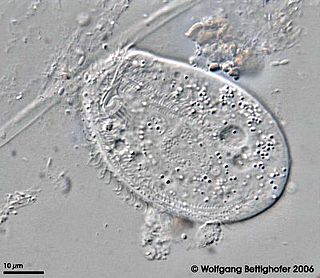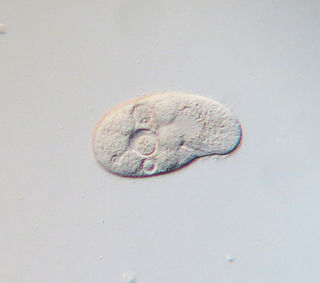
The cell is the basic structural and functional unit of life forms. Every cell consists of a cytoplasm enclosed within a membrane, which contains many biomolecules such as proteins and nucleic acids.

In cell biology, the nucleus is a membrane-bound organelle found in eukaryotic cells. Eukaryotes usually have a single nucleus, but a few cell types, such as mammalian red blood cells, have no nuclei, and a few others including osteoclasts have many. The main structures making up the nucleus are the nuclear envelope, a double membrane that encloses the entire organelle and isolates its contents from the cellular cytoplasm; and the nuclear matrix, a network within the nucleus that adds mechanical support, much like the cytoskeleton supports the cell as a whole.

A nuclear pore is a part of a large complex of proteins, known as a nuclear pore complex that spans the nuclear envelope, which is the double membrane surrounding the eukaryotic cell nucleus. There are approximately 1,000 nuclear pore complexes (NPCs) in the nuclear envelope of a vertebrate cell, but this number varies depending on cell type and the stage in the life cycle. The human nuclear pore complex (hNPC) is a 110 megadalton (MDa) structure. The proteins that make up the nuclear pore complex are known as nucleoporins; each NPC contains at least 456 individual protein molecules and is composed of 34 distinct nucleoporin proteins. About half of the nucleoporins typically contain solenoid protein domains—either an alpha solenoid or a beta-propeller fold, or in some cases both as separate structural domains. The other half show structural characteristics typical of "natively unfolded" or intrinsically disordered proteins, i.e. they are highly flexible proteins that lack ordered tertiary structure. These disordered proteins are the FG nucleoporins, so called because their amino-acid sequence contains many phenylalanine—glycine repeats.

Tetrahymena, a unicellular eukaryote, is a genus of free-living ciliates. The genus Tetrahymena is the most widely studied member of its phylum. It can produce, store and react with different types of hormones. Tetrahymena cells can recognize both related and hostile cells.

Paramecium is a genus of eukaryotic, unicellular ciliates, commonly studied as a representative of the ciliate group. Paramecia are widespread in freshwater, brackish, and marine environments and are often very abundant in stagnant basins and ponds. Because some species are readily cultivated and easily induced to conjugate and divide, it has been widely used in classrooms and laboratories to study biological processes. Its usefulness as a model organism has caused one ciliate researcher to characterize it as the "white rat" of the phylum Ciliophora.

A unicellular organism, also known as a single-celled organism, is an organism that consists of a single cell, unlike a multicellular organism that consists of multiple cells. Organisms fall into two general categories: prokaryotic organisms and eukaryotic organisms. All prokaryotes are unicellular and are classified into bacteria and archaea. Many eukaryotes are multicellular, but some are unicellular such as protozoa, unicellular algae, and unicellular fungi. Unicellular organisms are thought to be the oldest form of life, with early protocells possibly emerging 3.8–4.0 billion years ago.

The nucleoplasm is a type of protoplasm that makes up the cell nucleus, the most prominent organelle of the eukaryotic cell. It is enclosed by the nuclear envelope, also known as the nuclear membrane. The nucleoplasm resembles the cytoplasm of a eukaryotic cell in that it is a gel-like substance found within a membrane, although the nucleoplasm only fills out the space in the nucleus and has its own unique functions. The nucleoplasm suspends structures within the nucleus that are not membrane-bound and is responsible for maintaining the shape of the nucleus. The structures suspended in the nucleoplasm include chromosomes, nuclear bodies, nucleoporins, and nuclear speckles.

A heterokaryon is a multinucleate cell that contains genetically different nuclei. Heterokaryotic and heterokaryosis are derived terms. This is a special type of syncytium. This can occur naturally, such as in the mycelium of fungi during sexual reproduction, or artificially as formed by the experimental fusion of two genetically different cells, as e.g., in hybridoma technology.
The theory of cellularization, also known as the syncytial theory or ciliate-acoel theory, is a theory to explain the origin of Metazoa. The idea was proposed by Hadži and Hanson.
A macronucleus is the larger type of nucleus in ciliates. Macronuclei are polyploid and undergo direct division without mitosis. It controls the non-reproductive cell functions, such as metabolism. During conjugation, the macronucleus disintegrates, and a new macronucleus is formed by karyogamy of the micronuclei.

Micronucleus is the name given to the small nucleus that forms whenever a chromosome or a fragment of a chromosome is not incorporated into one of the daughter nuclei during cell division. It usually is a sign of genotoxic events and chromosomal instability. Micronuclei are commonly seen in cancerous cells and may indicate genomic damage events that can increase the risk of developmental or degenerative diseases. Micronuclei form during anaphase from lagging acentric chromosome or chromatid fragments caused by incorrectly repaired or unrepaired DNA breaks or by nondisjunction of chromosomes. This incorrect segregation of chromosomes may result from hypomethylation of repeat sequences present in pericentromeric DNA, irregularities in kinetochore proteins or their assembly, dysfunctional spindle apparatus, or flawed anaphase checkpoint genes. Micronuclei can contribute to genome instability by promoting a catastrophic mutational event called chromothripsis. Many micronucleus assays have been developed to test for the presence of these structures and determine their frequency in cells exposed to certain chemicals or subjected to stressful conditions.

Paramecium caudatum is a species of unicellular protist in the phylum Ciliophora. They can reach 0.33 mm in length and are covered with minute hair-like organelles called cilia. The cilia are used in locomotion and feeding. The species is very common, and widespread in marine, brackish and freshwater environments.

Nucleoporins are a family of proteins which are the constituent building blocks of the nuclear pore complex (NPC). The nuclear pore complex is a massive structure embedded in the nuclear envelope at sites where the inner and outer nuclear membranes fuse, forming a gateway that regulates the flow of macromolecules between the cell nucleus and the cytoplasm. Nuclear pores enable the passive and facilitated transport of molecules across the nuclear envelope. Nucleoporins, a family of around 30 proteins, are the main components of the nuclear pore complex in eukaryotic cells. Nucleoporin 62 is the most abundant member of this family. Nucleoporins are able to transport molecules across the nuclear envelope at a very high rate. A single NPC is able to transport 60,000 protein molecules across the nuclear envelope every minute.
Karyorelictea is a class of ciliates in the subphylum Postciliodesmatophora. Most species are members of the microbenthos community, that is, microscopic organisms found in the marine interstitial habitat, though one genus, Loxodes, is found in freshwater.

The ciliates are a group of protozoans characterized by the presence of hair-like organelles called cilia, which are identical in structure to eukaryotic flagella, but are in general shorter and present in much larger numbers, with a different undulating pattern than flagella. Cilia occur in all members of the group and are variously used in swimming, crawling, attachment, feeding, and sensation.

Chilodonella uncinata is a single-celled organism of the ciliate class of alveoles. As a ciliate, C. uncinata has cilia covering its body and a dual nuclear structure, the micronucleus and macronucleus. Unlike some other ciliates, C. uncinata contains millions of minichromosomes in its macronucleus while its micronucleus is estimated to contain 3 chromosomes. Childonella uncinata is the causative agent of Chilodonelloza, a disease that affects the gills and skin of fresh water fish, and may act as a facultative parasite of mosquito larva.

Colpidium colpoda are free-living ciliates commonly found in many freshwater environments including streams, rivers, lakes and ponds across the world. Colpidium colpoda is also frequently found inhabiting wastewater treatment plants. This species is used as an indicator of water quality and waste treatment plant performance.
Autogamy, or self-fertilization, refers to the fusion of two gametes that come from one individual. Autogamy is predominantly observed in the form of self-pollination, a reproductive mechanism employed by many flowering plants. However, species of protists have also been observed using autogamy as a means of reproduction. Flowering plants engage in autogamy regularly, while the protists that engage in autogamy only do so in stressful environments.
The genome of most cells of eukaryotes remains mainly constant during life. However, there are cases of genome being altered in specific cells or in different life cycle stages during development. For example, not every human cell has the same genetic content as red blood cells which are devoid of nucleus. One of the best known groups in respect of changes in somatic genome are ciliates. The process resulting in a variation of somatic genome that differs from germline genome is called somatic genome processing.

Tetrahymena thermophila is a species of Ciliophora in the family Tetrahymenidae. It is a free living protozoa and occurs in fresh water.














